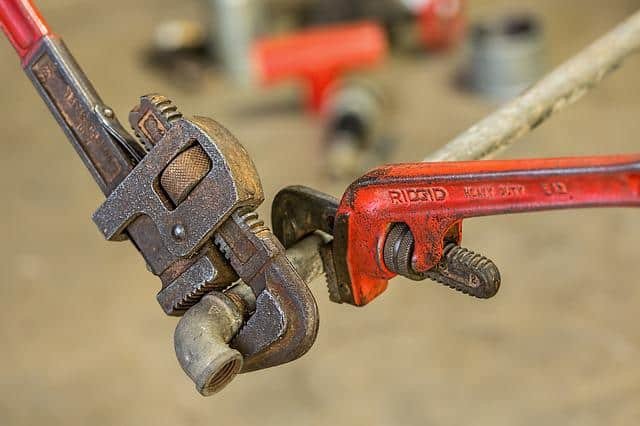What results in frozen pipes bursting?
This hotel has hosted former presidents Grant, Nixon, and Carter. Also staying there was former President George H.W. Bush, along with a number of governors and other notable figures.
However, the hoopla that surrounded their trips to the venerable Thayers Inn in Littleton, New Hampshire is likely to have paled in contrast to one of the establishment’s more recent attention-getters.
On a Friday in January of 2014, a waterfall emerged at the top of the inn’s grand staircase. Rivers also developed in the halls that lined the 1843 structure’s 39 guest rooms, while lakes formed in the inn’s first-floor parlors and restaurant.
A succession of severely cold temperatures had caused a water pipe to burst in the building’s attic, which resulted in an estimated flow of 1,900 liters (500 gallons) of water for every minute that the break went unchecked.
The process of turning off the water took ten to fifteen minutes, and during that time, enough water was lost to fill a regular-sized swimming pool. There was damage to the ceilings, the wood flooring bowed, and the antique furniture warped.
Disasters caused by burst pipes, such as this one, are exacerbated by continuing difficulties, some of which may be very costly. These problems include extensive structural damage and the development of mold.
Even the tiniest of cracks in a water pipe may allow as much as 250 gallons (950 liters) of water to escape each day.
The question now is: how can you tell whether the pipes in your house have frozen and are a potential catastrophe waiting to happen?
If you turn on the water faucet and no water comes out, or if you flush the toilet and the water does not refill, then it is likely that your water pipes are frozen. This can also happen if you flush the toilet and the water does not refill.
Alternately, if you turn on a faucet all the way and just a trickle of water comes out, this might be an indication that ice has formed within the water pipes and is preventing water from flowing freely.
In the event that you have reason to believe that one or more of your water pipes have frozen, it is time to get in touch with a plumber and shut off the water supply at the point where the main line enters your house.
Obviously, this piece of advise is only meant to be followed in regions in which the temperature has plummeted to be close to or below freezing (32 F or 0 C).
Temperatures that fall below minus 7 degrees Celsius (below 20 degrees Fahrenheit) pose a threat of freezing in plumbing systems because they put water at danger of solidifying. However, if the wind chill is taken into account, there is a possibility that water pipes may freeze even if the temperature is over 20 degrees Fahrenheit.
To the Point of Bursting at the Seams
A copper pipe has two breaks, both of which are leaking water. Leaks may occur at any point along the length of the pipe, although they are more likely to occur at the joints of the pipe.
A copper pipe has two breaks, both of which are leaking water. Leaks may occur at any point along the length of the pipe, although they are more likely to occur at the joints of the pipe.
They become more securely bound when the hydrogen and oxygen molecules that makeup water begin to transmit their heat to the frigid air that is all around them.
All of this huddling would result in the formation of solid, frozen stuff that would actually occupy less space than the liquid form if the arrangement of the hydrogen and oxygen molecules was allowed to stay constant.
However, water must be distinct in some way. Instead, the arrangement of its molecules changes when it freezes, and as a result, it takes up more room and expands as it transforms into ice.
And when it comes to the water pipes in your house, the expansion of water as it freezes may place a lot of stress on rigid metal and plastic pipes, as well as pipe joints. This can cause the pipes to burst or crack.
Take heed, innovators: If water pipes were fashioned out of a material that could expand, then the performance of the pipes would not be affected by freezing water, which would avoid damage to thousands of houses each year.
If I understand this correctly, the expansion of water into ice results in the rupture of water pipes. Not in any direct way. Instead, the issue arises when ice accumulates in a pipe and causes it to get stopped, often at many places along its length.
A rise in water pressure is brought on by the presence of these obstructions, which are situated between the water supply and the closed faucet.
The water may flow back to its source upstream of the ice dam without the pressure being increased. The water that is farther downstream from the ice obstruction is being prevented from escaping because the faucet is stopped off.
In the event that further ice develops, there is nowhere for it to go, and the pipe will explode as a result. Pipe joints are more prone to leaking, although fractures may appear anywhere along a pipe. Pipes can also break in other parts of the pipe.
If you are concerned that your pipes could freeze during the winter, one reason why it is a good idea to keep a faucet slightly ajar is because of this.
Some people are under the impression that the steady trickle prevents the water from freezing, but the reality is that water may freeze even while it is flowing. The primary advantage is that it reduces the amount of pressure.
Even while thawing pipes might cause them to rupture or start leaking, which leads some people to assume that the melting process is what causes difficulties, this is not the case.
The real damage will have happened days earlier when the pipes got frozen; however, you won’t know how much harm was done until the thaw starts since the ice blockage had been functioning as a clog until then. The actual damage will have occurred when the pipes became frozen.
Avoid a ‘Pipe’tastrophe by All Means
The majority of homes in the United States’ more northern states are constructed with water pipes that are shielded from the elements. Insulated water pipes are installed in heated, interior portions of a property.
Unheated attics, crawl spaces, and external walls are avoided as possible placement locations for these pipes. Homeowners in the warmer parts of the United States don’t always have the same good fortune.
Because freezing temperatures are uncommon, less consideration is given to the insulation of water pipes and their location during construction. This might result in a frozen mess, which would then become a watery disaster during a cold spell.
Wherever you reside, what are the most effective measures you can take to keep your water pipes from freezing?
Insulate the water pipes that are outside in the cold. It’s possible that these water pipes are situated in the crawl space or attic of a home, or even along an external wall. To assist in protecting pipes from freezing conditions, provide an additional layer of insulation to any location in which they may be found. Insulated pipes should have heat tape wrapped around them for further protection.
Close any cracks or leaks in your house that allow chilly air to enter, paying specific attention to those that are near your plumbing. Spots surrounding electrical, telephone, or cable wire that enters your house via an outside wall are common locations that are responsible for the problem. In addition, caulk the areas around the pipes and dryer vents.
When you’re smack in the heart of a cold snap, there are a few more safety measures you may take in addition to those already mentioned.
Keep a faucet open just enough so that water drips slowly or flows in a very slow stream throughout the day and night. If you have both a hot and cold sink, make sure that both of the faucets are open.
Even though it’s nighttime, you should keep the thermostat cranked up. A heated interior might assist in transferring heat to the water pipes located in your house.
If you want warm air to penetrate the area around the water pipes, you should open the cabinet doors beneath the sinks and along the outside walls.
Warm the pipe using a hair dryer if you believe that it has frozen or is in the process of freezing. First apply heat to the area near the faucet, and then go backward from there .
Big Bucks
What is the most typical reason for filing a claim on homeowner’s insurance?
Unfortunately, there seems to be water damage caused by broken pipes, a disaster that often results in a claim payment of around $5,000.
A Significant Amount of Further Data
Note from the Author: When pipes freeze, what causes them to rupture and cause water to spill out?
A broken water pipe caused some family friends of ours to be without the use of their kitchen for the last five weeks.
The problem was caused by the leak. They had to wait and watch while new flooring, cabinets, and appliances were built, and they resented having to take their infant and toddler out to eat for the majority of their meals during this time. She said that the cost was very high.
My acquaintance was surprised to find that there were not as many options available for food, particularly for someone who likes to consume full, organic foods in their diet.
It is impossible for me to see myself escorting infants and toddlers into a restaurant on a daily basis. Having to deal with it while on vacation is already a challenge. Do you agree that it would be taxing to try to work one’s way into a daily routine?
How Does One Go About Buying Homeowner’s Insurance?
Can Frozen Pipes Really Be Prevented By One Dripping Faucet?
6 Unexpected Exclusions From Homeowners Insurance





